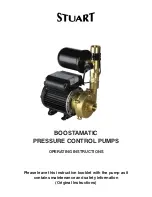
18
Subject to change without notice | 83053700gUK – Translation into English of the original German operating manual | ait-deutschland GmbH
Flushing and filling the unit
CAUTION.
The system must be absolutely free from air
before commissioning.
FLUSHING AND FILLING THE HEAT SOURCE
Contamination and deposits in the heat source can cause
malfunctions.
ATTENTION.
Before flushing and filling the heat source the
drain pipe of the safety valve must be connected
- Important: do not discharge into the drains
(anti-freeze mixture)!.
NOTE
The following antifreezes are approved for the
brine circuit:
•
Monopropylene glycol
•
Monoethylene glycol
•
Ethanol
•
Methanol
ATTENTION
Ensure that the (pipe) materials, seals and other
components used on site are made of materials
that are compatible with the antifreeze used!
WARNING!
Methanol and ethanol can evaporate, gi-
ving off flammable and explosive gases.
Therefore, the relevant antifreeze safety
regulations must be noted and followed!
Flush heat source system thoroughly.
Thoroughly mix the anti-freeze, available as an
accessory, with water with the required ratio.
Add only anti-freeze mixed with water to the heat
source.
ATTENTION.
The concentration of anti-freeze in the water
must be at the level specified for your model.
Overview “Technical data / scope of delivery”,
“Heat source” section.
Check the concentration of the anti-freeze in the
mixture…
Fill heat source with the anti-freeze mixture…
Bleed the heat source.
FLUSHING AND FILLING THE HEATING CIRCUIT
WATER QUALITY
OF THE FILL AND ADDITIONAL WATER IN HOT WATER
HEATING SYSTEMS ACCORDING TO VDI 2035 PART I
AND II
Use of modern, energy-efficient heat pump systems
is becoming increasingly widespread. Their ingenious
technology enables these systems to achieve very good
efficiencies. The decreasing space available for heat
generators has led to the development of compact
units with increasingly smaller cross-sections and high
capacities. This means the complexity of the systems and
the material diversity are also increasing, which plays an
important role especially in their corrosion behaviour.
The heating water not only affects the efficiency of the
system, but also the life of the heat generator and the
heating components of a system.
The guide values of VDI 2035 Part I and Part II must
therefore be complied with as minimum requirements
for proper operation of the systems. Our practical
experience has shown that the safest and most trouble-
free running of the systems is achieved with so-called
low-salt operation.
VDI 2035 Part I gives important information and
recommendations regarding scaling and its prevention in
heating and domestic hot water heating systems.
VDI 2035 Part II primarily deals with the requirements
for reducing heating water corrosion in hot water
heating systems.
PRINCIPLES OF PART I AND PART II
The occurrence of scaling and corrosion damage in hot
water heating systems is low, if
- proper planning and commissioning is carried out
- the system is closed in corrosion terms
- adequately dimensioned pressurising is integrated
- the guide values for the heating water are complied
with
















































